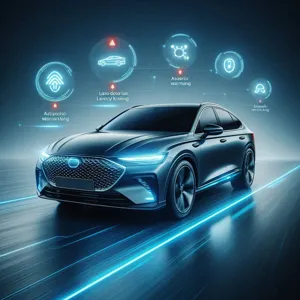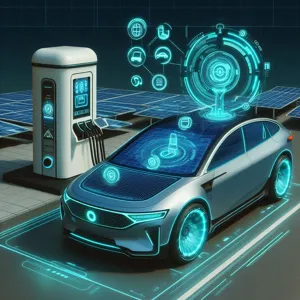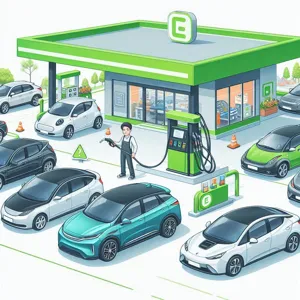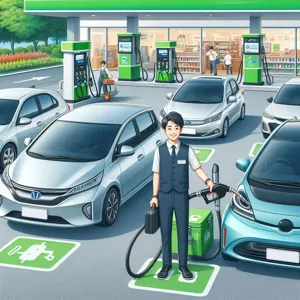As the automotive industry rapidly evolves, the thrill of driving is being redefined by an impressive array of innovative safety features designed to protect both drivers and passengers alike.
With advances in technology transforming the way we interact with our vehicles, modern cars are now equipped with cutting-edge systems that not only enhance safety but also elevate the overall driving experience. From adaptive cruise control and lane-keeping assistance to automatic emergency braking and advanced collision detection, these features work seamlessly to help prevent accidents and provide peace of mind on the road. In this blog post, we invite you to explore the latest safety enhancements that are shaping the future of driving, ensuring that every journey is not only enjoyable but also secure, as we delve into the remarkable advancements that promise to make our roads safer for everyone.
1. Introduction to Modern Car Safety Features

As we navigate the rapidly evolving landscape of automotive technology, one thing remains clear: safety is at the forefront of modern car design. Today’s vehicles are not just modes of transportation; they are sophisticated machines equipped with an array of cutting-edge safety features aimed at protecting drivers, passengers, and pedestrians alike. From advanced driver-assistance systems (ADAS) to smart connectivity features, the latest innovations are transforming how we think about road safety.
Gone are the days when safety was limited to seatbelts and airbags. Modern cars boast a suite of technologies designed to prevent accidents before they happen. Features such as adaptive cruise control, lane-keeping assistance, and automatic emergency braking are now standard in many vehicles, working harmoniously to create a safer driving experience. Furthermore, advancements in sensors and cameras provide real-time data to help drivers make informed decisions on the road.
But the future of car safety doesn’t stop there. As autonomous driving technology continues to develop, the integration of artificial intelligence and machine learning is paving the way for vehicles that can anticipate and react to potential hazards without human intervention. With each new model year, manufacturers are prioritizing safety in ways that were once unimaginable, striving to reduce the number of accidents and save lives.
In this blog post, we’ll explore some of the latest safety features that are redefining modern vehicles, highlighting how these advancements not only enhance driver confidence but also contribute to a safer environment for everyone on the road. Buckle up as we dive into the remarkable world of automotive safety technology!
2. The Evolution of Automotive Safety Technology
The evolution of automotive safety technology has transformed the driving experience, turning what was once a simple means of transportation into a highly sophisticated and secure journey. From the rudimentary seatbelt to the cutting-edge driver-assistance systems of today, safety innovations have continually advanced, reflecting both technological breakthroughs and a deeper understanding of human behavior on the road.
In the early days of the automobile, safety features were virtually non-existent. Drivers relied on their instincts and luck, with the most basic safety measure being the introduction of the seatbelt in the 1950s. Fast forward to the 21st century, and we witness a plethora of innovations designed to protect both drivers and pedestrians, drastically reducing accident rates and fatalities.
One of the most significant advancements is the development of airbags, which have evolved from a single front airbag to a network of sensors that deploy airbags in various locations throughout a vehicle, including front, side, and even knee airbags. These life-saving devices are now standard in most cars, working in conjunction with seatbelts to provide a comprehensive safety net during collisions.
Additionally, the rise of electronic stability control (ESC) has been a game changer. This technology helps drivers maintain control of their vehicles during extreme steering maneuvers, significantly lowering the risk of skidding and rollovers. Similarly, anti-lock braking systems (ABS) allow for better control during sudden stops, preventing wheel lockup and maintaining steering capability.
As we move into an era dominated by autonomous vehicles, safety features are set to become even more advanced. Technologies such as adaptive cruise control, lane-keeping assistance, and automatic emergency braking are now commonplace, relying on a combination of sensors, cameras, and artificial intelligence to enhance driver awareness and reduce the likelihood of accidents. These systems work tirelessly in the background, monitoring the vehicle’s surroundings and reacting faster than any human could, making roads safer for everyone.
The evolution of automotive safety technology is not just about protecting the occupants of a vehicle; it’s also about creating a safer environment for pedestrians and cyclists. Features like pedestrian detection systems and automatic braking ensure that vehicles can react to unforeseen obstacles, contributing to a holistic approach to road safety.
In conclusion, the journey of automotive safety technology has been remarkable, marked by continuous innovation and a commitment to reducing harm on the roads. As we look to the future, it’s clear that these advancements will only grow more sophisticated, making driving a safer experience for all.
3. Advanced Driver-Assistance Systems (ADAS)

Advanced Driver-Assistance Systems (ADAS) represent a significant leap forward in automotive safety and technology, providing drivers with a suite of features designed to enhance situational awareness and mitigate risks on the road. These systems leverage a combination of sensors, cameras, and artificial intelligence to assist drivers in making informed decisions, ultimately reducing the likelihood of accidents.
At the forefront of ADAS technology is adaptive cruise control, which allows vehicles to automatically adjust their speed based on the flow of traffic. This feature not only relieves the driver from constant acceleration and braking but also helps maintain a safe distance from the vehicle ahead, reducing the potential for rear-end collisions. Lane-keeping assist is another essential component of ADAS, using sensors to monitor lane markings and gently nudging the vehicle back into its lane if it begins to drift, thereby enhancing overall road safety.
Moreover, parking assistance systems take the stress out of maneuvering in tight spaces. With features like rear cross-traffic alert and automated parking, drivers can confidently navigate challenging parking scenarios while minimizing the risk of dings and dents. Forward collision warning and automatic emergency braking are also integral elements of ADAS, providing timely alerts and even intervening when necessary to prevent or reduce the severity of a collision.
As these technologies continue to evolve, the integration of machine learning and real-time data processing will only enhance their effectiveness, creating a safer driving environment. The advent of ADAS is not just about convenience; it’s a transformative step toward a future where driving is safer, more intuitive, and ultimately more enjoyable. As consumers become more aware of these advanced safety features, they are increasingly prioritizing vehicles equipped with ADAS, recognizing that peace of mind on the road is invaluable.
4. Collision Avoidance Systems: How They Work
Collision avoidance systems represent a significant leap forward in automotive safety technology, aimed at reducing the likelihood of accidents and protecting both drivers and pedestrians. At the heart of these systems is a combination of sensors, cameras, and advanced algorithms that work in concert to detect potential collision risks in real time.
The foundation of a collision avoidance system lies in its array of sensors, which typically include radar, lidar, and ultrasonic sensors. These devices continuously scan the vehicle’s surroundings, identifying nearby objects such as other vehicles, pedestrians, and even road signs. When the system detects a potential obstacle in the vehicle’s path, it quickly analyzes the speed and trajectory of both the vehicle and the object. Utilizing complex algorithms, the system determines whether a collision is imminent.
Once a potential collision is identified, the system alerts the driver through visual or auditory warnings, prompting them to take action. If the driver fails to respond in time, the collision avoidance system can intervene automatically. This intervention may involve several actions: reducing the vehicle’s speed, applying the brakes, or even steering the vehicle away from danger. Some advanced systems are even capable of executing a complete stop if necessary.
These technologies not only enhance driver awareness but also provide an extra layer of protection for pedestrians and cyclists. Many modern cars are equipped with pedestrian detection features that can identify individuals crossing in front of the vehicle, applying the brakes to prevent an accident. This capability is especially crucial in urban environments, where foot traffic is common and accidents can occur in the blink of an eye.
In essence, collision avoidance systems are designed to complement human instinct and decision-making, acting as a guardian on the road. As these technologies continue to evolve, we can expect even more sophisticated systems that not only help prevent accidents but also support the broader vision of autonomous driving, making our roads safer for everyone.
5. Adaptive Cruise Control: Enhancing Comfort and Safety

Adaptive Cruise Control (ACC) represents a significant leap forward in automotive technology, merging comfort with cutting-edge safety features to create a more relaxed driving experience. Unlike traditional cruise control, which maintains a constant speed set by the driver, ACC utilizes sophisticated sensors and radar systems to monitor the speed and distance of vehicles ahead. This intelligent system automatically adjusts your car’s speed to maintain a safe following distance, ensuring that you’re not only cruising at your desired speed but also responding dynamically to the flow of traffic.
Imagine embarking on a long road trip, the highway stretching endlessly before you. With ACC engaged, you can sit back and enjoy the drive without the constant need to adjust your speed as vehicles merge, slow down, or speed up around you. The system seamlessly accelerates or decelerates, allowing for a more leisurely and less stressful driving experience, especially in stop-and-go traffic.
Safety is where ACC truly shines. By minimizing the likelihood of collisions due to sudden stops or unexpected slowdowns, it acts as a second set of eyes on the road, enhancing your awareness and reaction times. Many modern vehicles equipped with ACC come with additional safety features such as Forward Collision Warning (FCW) and Automatic Emergency Braking (AEB), which work in tandem to further protect you and your passengers.
Moreover, the convenience of ACC doesn’t just enhance comfort; it fosters better driving habits. By maintaining a consistent following distance and reducing the need for abrupt stops and starts, drivers can experience improved fuel efficiency, making it a win-win for both comfort and the environment.
As we drive into the future, Adaptive Cruise Control stands out not just as a luxury feature but as a vital component of advanced driver-assistance systems (ADAS), paving the way for a safer and more enjoyable journey on the roads ahead. Whether you’re navigating through city streets or cruising on the highway, ACC is an innovation designed to keep you in control while prioritizing your safety and comfort.
6. Lane Keeping Assist and Lane Departure Warning Systems
As we cruise into an era defined by technological innovation, lane-keeping assist and lane departure warning systems are leading the charge in enhancing road safety. These advanced features are designed to help drivers maintain their position within designated lanes, significantly reducing the risk of accidents caused by unintentional lane changes.
Lane Departure Warning (LDW) systems serve as vigilant guardians, utilizing cameras and sensors to monitor lane markings on the road. If the system detects that your vehicle is drifting out of its lane without signaling, it promptly alerts you with visual or auditory warnings, ensuring you’re aware of your vehicle’s positioning. This feature is particularly beneficial during long drives or in situations of fatigue, where a momentary lapse in attention could lead to dangerous consequences.
Complementing LDW, Lane Keeping Assist (LKA) takes the technology a step further. When the system senses that you’re straying out of your lane, it actively intervenes by subtly adjusting the steering to guide you back on track. This hands-on approach provides an additional layer of security, making it especially valuable in highway driving or on winding roads where maintaining lane discipline is crucial.
Together, these systems not only enhance driver awareness but also foster a sense of confidence behind the wheel. As more manufacturers incorporate lane-keeping assist and lane departure warning systems into their vehicles, drivers can look forward to a safer, more enjoyable driving experience—a true testament to how modern technology is reshaping the way we travel. With these features, staying centered in your lane has never been easier, making long journeys less stressful and significantly enhancing road safety for everyone.
7. Automatic Emergency Braking: A Life-Saving Feature

In the fast-paced world of modern driving, safety features have evolved far beyond the basic seatbelt and airbag systems. One of the standout innovations making waves in the automotive industry is Automatic Emergency Braking (AEB). This life-saving feature is designed to assist drivers in avoiding potential collisions, significantly enhancing road safety for everyone.
Automatic Emergency Braking uses a combination of radar, cameras, and sensors to monitor the road ahead. When the system detects an imminent collision with another vehicle, pedestrian, or obstacle, it automatically applies the brakes if the driver fails to react in time. This critical intervention can occur in a fraction of a second, often preventing accidents or reducing the severity of a crash.
Imagine cruising down a busy city street, engaged in conversation or distracted by your smartphone, when suddenly a car unexpectedly cuts into your lane. With AEB, your vehicle would spring into action, applying the brakes before your brain even registers the danger. This proactive safety net is especially beneficial in urban environments, where sudden stops and unpredictable pedestrians are commonplace.
Furthermore, many modern vehicles come equipped with advanced AEB systems that can function at various speeds, whether in stop-and-go traffic or on the highway. Some models even incorporate additional features, like pedestrian detection and cyclist detection, further expanding the scope of protection.
The impact of Automatic Emergency Braking on road safety is profound. Studies show that vehicles equipped with AEB can significantly reduce the likelihood of rear-end collisions, leading to fewer injuries and fatalities on the roads. As this technology continues to advance and become standard in many new vehicles, it represents a significant step forward in our collective journey toward safer driving.
As you consider your next vehicle purchase, keep an eye out for Automatic Emergency Braking and other advanced safety features. Investing in a car that prioritizes safety not only protects you but also contributes to a safer environment for all road users. In a world where every moment counts, AEB is a remarkable example of how technology can help safeguard lives on the road.
8. Blind Spot Monitoring: Driving with Confidence
### 8. Blind Spot Monitoring: Driving with Confidence
As we navigate the bustling roads of today, one of the most significant advancements in vehicle safety technology is the introduction of Blind Spot Monitoring (BSM) systems. This feature has rapidly become a must-have for modern drivers, as it enhances the driving experience by instilling a sense of confidence and security.
Blind Spot Monitoring utilizes sensors strategically placed in the rear and sides of your vehicle to detect the presence of other vehicles in your blind spots—those hard-to-see areas that traditional mirrors often miss. When another vehicle enters your blind spot, the system alerts you through visual indicators on your side mirrors or dashboard, and in some advanced models, audible warnings may also sound. This proactive notification allows drivers to make informed decisions when changing lanes or merging, significantly reducing the risk of collisions.
The technology behind BSM is remarkably sophisticated yet simple to use. It operates seamlessly in the background, continuously scanning the surrounding area while you focus on the road ahead. In high-traffic situations where quick maneuvers are necessary, such as city driving or highway merges, having the added reassurance of blind spot detection can truly be a game-changer.
Moreover, many manufacturers have taken BSM a step further by integrating it with other safety features, such as Lane Keeping Assist and Collision Avoidance Systems. These synergies not only amplify the effectiveness of blind spot monitoring but also contribute to a holistic approach to vehicle safety, ensuring that drivers are fully supported in a variety of driving scenarios.
Ultimately, Blind Spot Monitoring is not just about preventing accidents; it’s about empowering drivers to navigate their journeys with greater peace of mind. As we drive into the future, features like BSM bring us closer to a safer, more confident driving experience, allowing us to enjoy the open road with less stress and enhanced awareness. After all, in the world of modern cars, safety is not just an add-on; it’s an integral part of the driving experience.
9. Rearview Cameras and Parking Assistance Technologies
As we navigate the busy roads and crowded parking lots of today’s world, safety features in vehicles have advanced significantly, with rearview cameras and parking assistance technologies leading the charge. These innovations are not just conveniences; they are essential tools designed to enhance driver awareness and reduce the likelihood of accidents.
Rearview cameras have become a standard feature in many modern vehicles, offering drivers a clear view of what lies behind them when reversing. With a wide-angle lens and high-definition resolution, these cameras provide a panoramic perspective, allowing you to spot obstacles, pedestrians, or other vehicles that may be lurking in your blind spots. The image is displayed on an in-dash screen, making it easy to eliminate the guesswork when backing up. Additionally, many rearview cameras are equipped with dynamic guidelines that adjust as you turn the steering wheel, helping you navigate tight spaces with precision.
Complementing rearview cameras are advanced parking assistance technologies, which take the stress out of parallel parking and tight maneuvers. Utilizing a series of sensors strategically placed around the vehicle, these systems can detect nearby objects and calculate available parking spaces. Some models even come with automated steering capabilities, allowing the car to steer itself into a parking spot while the driver merely controls the gas and brake pedals. This feature is particularly beneficial for those who may feel anxious about parking in busy areas or for new drivers still honing their skills.
Moreover, many vehicles today integrate both rearview cameras and parking assistance systems with other safety technologies, such as blind-spot monitoring and cross-traffic alerts. This synergy creates a comprehensive safety net, ensuring that drivers are acutely aware of their surroundings, even in the most challenging situations.
In essence, rearview cameras and parking assistance technologies represent a significant leap forward in vehicle safety, providing drivers with the tools they need to navigate their world confidently. As these technologies continue to evolve, they promise to make driving not only safer but also more enjoyable, paving the way for a future where road safety is paramount.
10. Vehicle-to-Vehicle Communication: The Future of Safety
As we navigate the ever-evolving landscape of automotive technology, one of the most groundbreaking advancements on the horizon is Vehicle-to-Vehicle (V2V) communication. Imagine a world where cars can talk to each other, sharing vital information in real-time to enhance safety on our roads. This innovative feature is poised to revolutionize how vehicles interact, leading to a significant reduction in accidents and an overall safer driving experience.
At its core, V2V communication allows vehicles to exchange data about their speed, direction, and location, creating a comprehensive picture of their surroundings. This information is transmitted using dedicated short-range communications (DSRC) or cellular networks, enabling vehicles to alert one another to potential hazards. For instance, if a car suddenly brakes ahead, vehicles behind can receive an alert, allowing drivers to respond promptly and avoid a collision.
Moreover, V2V technology can facilitate smarter traffic management. Imagine a scenario where multiple cars approaching a busy intersection can communicate with each other and traffic signals to optimize flow, reducing congestion and the likelihood of accidents. Additionally, this communication can extend to emergency vehicles, allowing them to navigate through traffic more efficiently, ensuring they reach their destinations rapidly—ultimately saving lives.
While V2V communication is still in its infancy, several manufacturers and governments are investing heavily in this technology. With ongoing advancements in infrastructure and vehicle capabilities, we are on the brink of a new era in road safety. As we drive into the future, the promise of V2V communication stands out as a beacon of hope, paving the way for a safer, more connected world for all road users. Embracing this technology is not just about enhancing the driving experience; it’s about safeguarding lives and creating a community of vehicles that look out for one another.
11. Impact of Artificial Intelligence on Car Safety
As we drive toward an increasingly automated future, the impact of artificial intelligence (AI) on car safety is nothing short of revolutionary. Modern vehicles are no longer just modes of transportation; they are sophisticated machines equipped with advanced AI technologies designed to enhance safety and prevent accidents. These innovations are transforming the driving experience, making it safer for all road users.
One of the most notable applications of AI in car safety is the development of advanced driver assistance systems (ADAS). These systems utilize a combination of sensors, cameras, and machine learning algorithms to monitor and interpret the driving environment. Features such as lane-keeping assist, adaptive cruise control, and automatic emergency braking are just a few examples of how AI is actively working to minimize human error—one of the leading causes of accidents.
Moreover, AI is also paving the way for predictive safety measures. By analyzing data from various sources, including traffic patterns and weather conditions, AI can anticipate potential hazards before they occur. For instance, if the system detects that a driver is approaching a dangerous intersection at a high speed, it can alert the driver and even engage the brakes if necessary. This proactive approach to safety can significantly reduce the likelihood of collisions.
Additionally, the integration of AI-powered technology in vehicles allows for constant software updates, ensuring that safety features remain cutting-edge over time. Manufacturers can refine algorithms based on real-world driving data, continually enhancing the vehicle’s ability to respond to new challenges on the road.
As we look to the future, the potential of AI in improving car safety continues to expand. The ongoing research and development in this field promise even more innovative features, such as fully autonomous vehicles equipped with fail-safe systems that can make split-second decisions to protect passengers and pedestrians alike. In essence, artificial intelligence is not just making cars smarter; it is fundamentally redefining what it means to drive safely in the modern world.
12. The Role of Data Analytics in Enhancing Safety Features
In the ever-evolving landscape of automotive technology, data analytics plays a pivotal role in enhancing safety features in modern cars. As vehicles become increasingly equipped with sensors and connectivity options, they generate vast amounts of data that can be harnessed to improve safety measures significantly. This data-driven approach allows manufacturers to analyze driving patterns, environmental conditions, and even vehicle performance in real-time, leading to more informed decisions and proactive safety measures.
For example, advanced driver-assistance systems (ADAS) utilize data analytics to interpret information from various sensors, including cameras, radar, and lidar. These systems can detect obstacles, monitor blind spots, and even predict potential collisions, making driving safer for everyone on the road. By continuously analyzing data from thousands of vehicles, manufacturers can identify trends and recurring issues, leading to timely updates and enhancements to safety features.
Moreover, the integration of machine learning algorithms allows vehicles to learn from historical data and adapt their safety protocols accordingly. This means that as the number of vehicles on the road increases, the systems can evolve, becoming smarter and more responsive to the dynamic driving environment. For instance, predictive analytics can anticipate hazardous situations by recognizing patterns in road conditions and traffic behaviors, providing alerts and recommendations to drivers before a potential accident occurs.
Additionally, data analytics extends beyond just the vehicle itself. It plays a crucial role in the broader context of traffic safety by informing infrastructure improvements and policy decisions. Analyzing data collected from connected vehicles can reveal high-risk areas or times for accidents, enabling city planners and authorities to devise strategies that enhance road safety.
As we drive into the future, the synergy between data analytics and automotive safety features not only empowers manufacturers to create safer vehicles but also fosters a culture of continuous improvement. The result is a more secure driving experience, where both drivers and pedestrians can benefit from the advancements in technology and data utilization. With each new model, we inch closer to a future where safety on the roads is not just a goal but a standard.
13. Safety Ratings and Testing Standards: What to Look For
When it comes to choosing a modern vehicle, understanding safety ratings and testing standards is essential for making an informed decision. These ratings provide a clear picture of how well a car performs in various crash scenarios and how effectively it can protect its occupants. Organizations such as the National Highway Traffic Safety Administration (NHTSA) and the Insurance Institute for Highway Safety (IIHS) conduct rigorous testing to evaluate vehicles based on a series of standardized assessments, including frontal crashes, side-impact collisions, and rollover tests.
As you navigate the dealership or browse online, keep an eye out for the star ratings that these organizations assign. A higher star rating generally indicates a safer vehicle, while the IIHS’s “Top Safety Pick” designation signifies that a car has excelled in multiple crash tests and is equipped with advanced safety features. These ratings are not just numbers; they offer real insight into how well a vehicle can protect you and your loved ones during an unfortunate event.
In addition to crash test ratings, it’s also important to consider the advanced safety technologies integrated into the car. Look for features such as automatic emergency braking, lane departure warning systems, and adaptive cruise control. These technologies not only enhance the driving experience but also provide an extra layer of protection by helping to prevent accidents before they occur.
Finally, remember that safety is not a static feature; it’s an evolving standard. Manufacturers continuously improve their safety protocols and technologies to keep up with changing regulations and consumer expectations. Therefore, it’s wise to research the latest models and their safety advancements before making a purchase. By prioritizing safety ratings and testing standards, you ensure that the vehicle you choose is equipped to handle the uncertainties of the road ahead, paving the way for a secure driving experience.
14. The Future of Car Safety: Trends and Innovations
As we steer into the future, the landscape of automotive safety is evolving at an unprecedented pace. With technology advancing rapidly, modern cars are equipped with a plethora of innovative features designed to enhance driver and passenger safety. One of the most significant trends is the integration of artificial intelligence (AI) into vehicle systems. AI-driven features, such as predictive collision detection, analyze real-time data from various sensors to anticipate potential accidents, allowing for preemptive actions like automatic braking or steering adjustments.
Another noteworthy innovation is the development of advanced driver-assistance systems (ADAS). These systems, which encompass features like lane-keeping assist, adaptive cruise control, and blind-spot monitoring, work seamlessly to provide a safer driving experience. They use a combination of cameras, radar, and ultrasonic sensors to create a comprehensive view of the vehicle’s surroundings, significantly reducing the likelihood of human error—a leading cause of accidents.
Moreover, the rise of connected cars has opened up new possibilities for safety. Vehicles that communicate with one another and with traffic infrastructure can share critical information about road conditions, hazards, and traffic patterns. This connectivity not only enhances situational awareness but also allows for coordinated responses to potential dangers, such as warning drivers of an impending collision or alerting emergency services to accidents in real-time.
In addition to these technological advancements, manufacturers are increasingly focusing on the design and materials of vehicles themselves. Enhanced structural integrity, crumple zones, and advanced airbag systems are becoming standard, ensuring that cars can better protect occupants in the event of a crash. Furthermore, the trend towards electric vehicles (EVs) is leading to innovations in battery safety, with features designed to prevent overheating and mitigate fire risks.
As we look to the future, the commitment to car safety continues to grow, driven by a combination of cutting-edge technology, innovative design, and a deeper understanding of human behavior. The result is a new generation of vehicles that not only prioritize safety but also strive to make the driving experience more enjoyable and secure for everyone on the road. The future of car safety is bright, and it promises to keep us all safe as we navigate the highways and byways of tomorrow.
15. Conclusion: Embracing Technology for Safer Driving
As we steer into the future of automotive innovation, it’s clear that technology is not just enhancing our driving experience but also redefining safety standards. The latest advancements in vehicle safety features are transforming how we interact with our cars, making roads safer for everyone. From advanced driver-assistance systems (ADAS) such as adaptive cruise control and lane-keeping assist to groundbreaking innovations like automatic emergency braking and pedestrian detection, today’s vehicles are equipped with a suite of tools designed to prevent accidents and protect lives.
Embracing these technologies means more than just adopting new gadgets; it signifies a commitment to a safer driving environment. With real-time data analysis and machine learning algorithms, modern vehicles can now predict and respond to potential hazards with astonishing accuracy, significantly reducing the likelihood of collisions. As consumers, we have the power to choose cars that prioritize safety, ensuring that we and our loved ones are protected on every journey.
Moreover, as these technologies continue to evolve, we can look forward to future breakthroughs that promise even greater protection. Features like vehicle-to-vehicle (V2V) communication, which allows cars to share information about their surroundings, and the integration of artificial intelligence in driving systems are on the horizon, paving the way for a safer, smarter road ahead.
In conclusion, embracing technology for safer driving is not just a trend; it’s an imperative for reducing road fatalities and enhancing the overall driving experience. By staying informed and advocating for the adoption of these advanced safety features, we can contribute to a future where every trip is as safe as it is enjoyable. Let us embrace this promising era of automotive safety and drive confidently into the future.
As we navigate the ever-evolving landscape of automotive technology, it’s clear that modern cars are not just about performance and aesthetics; they are increasingly designed with safety as a top priority. From advanced driver-assistance systems to innovative collision-avoidance technologies, the latest safety features are revolutionizing the way we drive and ensuring greater peace of mind on the road. We hope this exploration of cutting-edge safety advancements has inspired you to consider how these innovations can enhance your driving experience. As you embark on your next car purchase or simply stay informed about the automotive industry, remember that a commitment to safety is paramount for both you and your loved ones. Buckle up and drive into the future with confidence, knowing that the latest safety features are here to protect you every mile of the way!




































